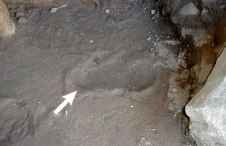Atlatls
From at least 8300 years ago, and probably earlier, Nevada's ancient Native Americans used the atlatl or throwing stick to propel feathered and, usually, stone tipped darts at their prey. In fact, most “arrowheads” found in the desert are most likely atlatl dart points. Although Native Americans are more typically associated with the bow and arrow, Archaeologists trace the introduction of the bow into Nevada to sometime between 3000 and 1000 years ago, a time relatively late in North American prehistory.
The name atlatl is derived from the Aztec name for this weapon, and it is also known as a throwing stick or spear thrower. It is quite possible that the atlatl and dart were brought into North America by predecessors of the Native Americans from Asia or Europe and it was known to have been used by Aztecs and Australian aborigines.
Functionally, the atlatl is an extension of the thrower's arm. This adds considerable leverage and allows the dart to be propelled with increased force. The essential components of the atlatl are the shaft and spur. A spur or hook is found at the end of the atlatl shaft—the side held farthest away from the body. The base of the dart has a cup-shaped depression, which allows it to sit in the spur. The dart shaft is usually held by the thrower with the thumb and index finger of the hand gripping the atlatl handle; the free hand can also be used.
As the atlatl is whipped forward, the grip on the dart shaft is released, and the dart is forced forward until it disengages from the spur. Most atlatls have a stone or “weight” attached to the shaft of the atlatl. This increased mass adds additional thrust to the release. Atlatls are commercially made today from a variety of traditional and non-traditional materials for use in sport and hunting.
Article Locations
Related Articles
Further Reading
None at this time.





